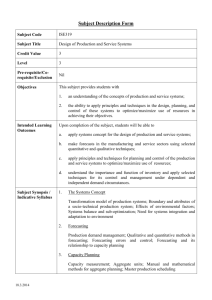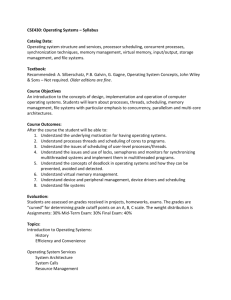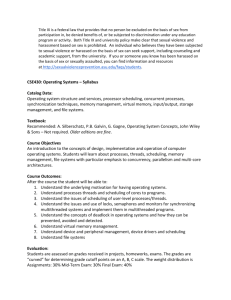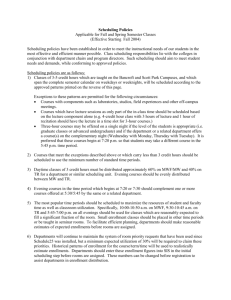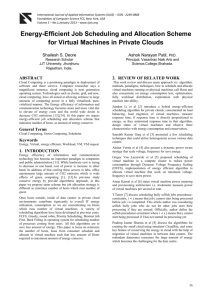1. Which of the following is true regarding forward scheduling?
advertisement
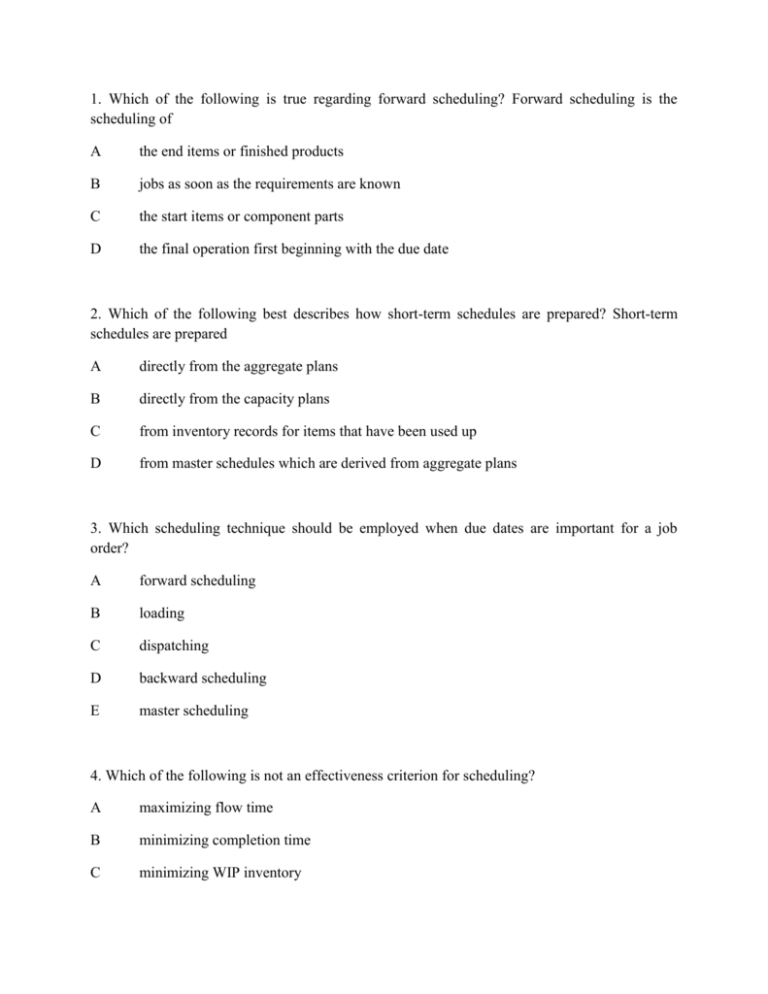
1. Which of the following is true regarding forward scheduling? Forward scheduling is the scheduling of A the end items or finished products B jobs as soon as the requirements are known C the start items or component parts D the final operation first beginning with the due date 2. Which of the following best describes how short-term schedules are prepared? Short-term schedules are prepared A directly from the aggregate plans B directly from the capacity plans C from inventory records for items that have been used up D from master schedules which are derived from aggregate plans 3. Which scheduling technique should be employed when due dates are important for a job order? A forward scheduling B loading C dispatching D backward scheduling E master scheduling 4. Which of the following is not an effectiveness criterion for scheduling? A maximizing flow time B minimizing completion time C minimizing WIP inventory D maximizing utilization 5. Forward scheduling A begins with a delivery date, then each operation is offset one at a time, in reverse order B is well suited where the supplier is usually able to meet precise delivery dates C tends to minimize in-process inventory D assumes that procurement of material and operations start as soon as requirements are known 6. Which file contains important information regarding an item's flow through the shop? A routing file B work center master file C control files D item master file 7. Which of these is not part of the planning files of a production planning and control system? A a progress file B a work center master file C an item master file D a routing file 8. Which of the following files tracks work order progress? A work center master files B routing files C item master files D control files 9. The production database containing information about each of the components that a firm produces or purchases is the A routing file B work center master file C control file D item master file 10. The short-term scheduling activity called loading A assigns dates to specific jobs or operations steps B specifies the order in which jobs should be done at each center C assigns jobs to work centers D assigns workers to jobs 11. The assignment method is A a method to highlight overloads in a given work center B a computerized method of determining appropriate tasks for an operation C a form of linear programming for optimally assigning tasks or jobs to resources D the same thing as the Gantt schedule chart 12. A scheduling technique used to achieve optimum, one-to-one matching of tasks and resources is A the assignment method B Johnson's rule C the CDS Algorithm D the appointment method 13. Which of the following is an aid used to monitor jobs in process? A a Gantt load chart B the assignment method C a Gantt schedule chart D Johnson's Rule 14. If an assignment problem consists of 6 workers and 7 projects, A one worker will not get a project assignment B one worker will be assigned two projects C each worker will contribute work toward the seventh project D one project will not get a worker assigned 15. Orders are processed in the sequence in which they arrive if (the) ______ rule sequences the jobs. A earliest due date B slack time remaining C first come, first serve D critical ratio 16. Which of the following dispatching rules ordinarily gives the best results when the criterion is lowest time for completion of the full sequence of jobs? A shortest processing time (SPT) B critical ratio (CR) C first in, first out (FIFO) D first come, first serve (FCFS) 17. Sequencing (or dispatching) A assigns dates to specific jobs or operations steps B assigns jobs to work centers C specifies the order in which jobs should be done at each center D assigns workers to jobs 18. Flow time represents the time A an order spends waiting for processing at a work center B an order spends being processed at a work center C an order spends moving from one work center to another D to complete an order, including time spent in processing and in waiting 19. Which of the following dispatching rules tends to minimize job flow time? A FCFS: first come, first served B SPT: shortest processing time C EDD: earliest due date D LPT: longest processing time 20. Average completion time for a schedule sequence at a work center is total A processing time divided by the number of jobs B flow time divided by total processing time C flow time divided by the number of jobs D processing time plus total late time divided by number of jobs Answer of MCQ 1-b 2-d 14-d 3-d 15-c 4-a 16-a 5-d 17-c 6-a 18-d 7-a 19-b 8-d 20-c 9-d 10-c 11-c 12-a 13-c 1. Which of the following dispatching rules allows easy updates? A FCFS: first come, first served B SPT: shortest processing time C EDD: earliest due date D CR: critical ratio 2. The priority rule which processes jobs according to the smallest ratio of due date to processing time is: A critical ratio B earliest due date C first come, first serve D longest processing time 3. Which of the following is an advantage of the FCFS dispatching rule when used in services? A FCFS seems fair to customers B FCFS minimizes the average number of jobs in the system C FCFS minimizes the average lateness of all jobs D FCFS maximizes the number of jobs completed on time 4. The most appropriate sequencing rule to use if the goal is to dynamically track the progress of jobs and establish relative priority on a common basis is A shortest processing time B earliest due date C critical ratio D Johnson's rule 5. Use of the sequencing rule Shortest Processing Time generally results in A minimum average lateness B maximum utilization C maximum effectiveness D minimum average flow time 6. When a set of jobs must pass through two workstations whose sequence is fixed, ______ is the rule most commonly applied. A Johnson's Rule B earliest due date rule C first come, first serve rule D slack time remaining 7. A recent advance in short-term scheduling that makes use of expert systems and simulation in solving dynamic scheduling problems is A forward scheduling B backward scheduling C infinite scheduling D finite scheduling 8. Which of the following techniques does not contribute to increasing throughput at a bottleneck? A schedule throughput to match capacity of the bottleneck B increase capacity of constraint C have cross-trained employees available to operate the constraint D develop alternate routings 9. An appliance manufacturer assembles icemakers in large batches. The operations manager would like to significantly reduce the batch size. What would you suggest? A use the SPT rule B use forward scheduling C use finite scheduling D develop level material use schedules 10. Which of the following is true regarding services scheduling? A The Critical Ratio sequencing rule is widely used for fairness to customers. B The emphasis is on staffing levels, not materials. C Reservation systems are often used a means of manipulating the supply of services. D Labor use can be intensive, and labor demand is usually stable. Answer of MCQ 1-d 2-a 3-a 4-c 5-d 6-a 7-d 8-a 9-d 10-b 1 Which of the following time series forecasting methods would NOT be used to forecast a time series that exhibits a linear trend with no seasonal or cyclical patterns? A) Dummy variable regression. B) Linear trend regression. C) Multiplicative Winters’ method. D) A and D 2 Which of the following is not a component of time series? A) trend B) seasonal variations C) cycle D) smoothing 3 To check for positive or negative first-order autocorrelation, we can use A) the Durbin-Watson statistic. B) a one sample t test. C) multiplicative Winters’ method. D) dummy variable regression. 4 If the errors produced by a forecasting method for 3 observations are -1, -2, and -6, then what is the mean squared error (deviation)? A) 9 B) -9 C) 3 D) 13.67 5 A restaurant has been experiencing higher sales during the weekends as compared to the weekdays. Daily restaurant sales patterns for this restaurant over a week are an example of the ______ component of time series. A) trend B) seasonal C) cyclical D) irregular 6 The ___________ component of a time series measures the fluctuations in a time series due to economic conditions of prosperity and recession with a duration of approximately 2 years or longer. A) trend B) seasonal C) cyclical D) irregular 7 The ______________ component of a time series reflects the long-run decline or growth in a time series. A) trend B) seasonal C) cyclical D) irregular 8 The _______________ component of a time series refers to the erratic time-series movements that follow no recognizable or regular pattern over a period of time. A) trend B) seasonal C) cyclical D) irregular 9 A __________ is obtained by dividing the current value of a time series by the value of the time series in the base time period and by multiplying this ration by 100. A) aggregate index B) simple index C) price index D) quantity index. 10 Which of the following time-series forecasting methods would not be used to forecast seasonal data? A) Dummy variable regression. B) Simple exponential smoothing. C) Time-series decomposition. D) All of the above can be used to forecast seasonal data. Answer of MCQ 1-d 2-d 3-a 4-d 5-b 6-c 7-a 8-d 9-b 1 Which of the following is not a reason for carrying inventory? A) to maintain independence of operations B) to take advantage of economic purchase-order size C) to make the system less productive D) to meet variation in product demand 10-b 2 Counting items to ensure an order is correct, is an example of: A) Setup cost B) ordering cost C) carrying cost D) stockout cost 3 Independent demand is: A) inventory whose demand comes from independent suppliers B) inventory that is independent of any known rules of demand and supply C) demand that is related to the demand for another item D) demand determined by the marketplace that requires forecasting 4 The basic difference between P and Q systems is: A) Q models are event triggered while P models are time triggered B) Q models are time triggered while P models are event triggered C) P models favor more expensive items D) P model is more appropriate for important items such as critical repair parts 5 Which of the following is not an assumption of the basic economic-order quantity model? A) annual demand is constant and known B) lead time is constant C) ordering or setup costs are constant D) quantity discounts are available 6 In the basic fixed-order quantity model, if annual demand doubles, the effect on the Optimal Order Quantity (EOQ) is: A) it doubles B) it is half its previous amount C) it increases by about 40% D) decreases by a factor of 2 7 Which of the following statements is true about the Q-system? A) It does not have a reorder point but rather a target inventory. B) The system is completely determined by the two parameters, Q and R. C) It does not have an EOQ, since the quantity varies according to demand. D) The order interval is fixed not the order quantity. 8 ABC analysis typically requires that inventory be classified according to: A) alphabetical order by item name B) annual dollar volume C) alphabetical order by supplier name D) due date 9 In the basic Q model, if the lead time doubles, the EOQ will: A) decrease by half B) double C) remain the same D) increase, but not double 10 Three simple inventory systems often used in practice are: A) Optional replenishment or min/max system B) One-bin system C) Two-bin system D) All the above Answer of MCQ 1-c 2-b 3-d 4-a 5-d 6-c 7-b 8-b 9-c 10-d 1 Goods producers are the primary users of yield management because it enhances their bottom lines. A) True B) False 2 A master schedule is used to assign workers to specific jobs. A) True B) False 3 Rough cut capacity planning is used to test the feasibility of a proposed master schedule. A) True B) False 4 Capacity requirements can be more difficult to predict for services than for manufacturing. A) True B) False 5 Disaggregating the aggregate relates to A) yield management B) planning a chase approach C) master scheduling D) short-range planning 6 Which one is not considered a capacity option? A) Use of backorders. B) Use of overtime. C) Use of subcontractors. D) Use of temporary workers. 7 Which one is not a disadvantage of a level approach compared to a chase approach? A) greater inventory costs. B) increased overtime and idle time C) varying resource utilization D) varying workforce levels 8 The terms frozen, slushy, and liquid are most closely associated with A) yield management B) time fences C) rough-cut capacity planning D) a chase strategy 9 The term available-to-promise is most closely associated with A) sales and operations planning B) rough-cut capacity planning C) disaggregating the aggregate plan D) master production scheduling 10 Which one is unrelated to the master scheduling process? A) yield management B) rough-cut capacity planning C) time fences. D) available-to-promise Answer of MCQ 1-b 2-a 3-a 4-a 5-c 6-a 7-d 8-b 9-d 10-a 1 The term balance delay refers to the percentage of idle time for a line. A) True B) False 2 The minimum cycle time of a line is equal to the time of the shortest task. A) True B) False 3 Cycle time is the time allowed at each work station to complete a set of tasks. A) True B) False 4 A DVD player would most likely be repaired in this type of layout: A) fixed position B) hybrid C) product D) process 5 Which system has the least flexibility? A) job shop B) batch C) assembly D) continuous 6 Which type of operation would be most closely associated with division of labor? A) job shop B) batch C) assembly D) continuous 7 The type of layout that would be used to build a submarine is: A) fixed-position B) product C) process D) aquatic 8 Which processing system would be the least likely choice for producing a pair of shoes? A) assembly B) batch C) continuous D) job shop 9 Which two types of processing systems would most likely be used to produce iPods? A) continuous or assembly B) assembly or batch C) batch or job shop 10 Product or service profiling links key product or service requirements to A) market conditions B) pricing strategies C) process capabilities D) schedule changes E) order sizes 11 Which one does not relate to designing process layouts? A) Minimizing transportation costs. B) Minimizing distance traveled. C) Focusing on closeness ratings. D) Equalizing times of work stations. 12 In a Muther closeness grid, which symbol is used for a location if closeness isn't important? A) A B) E C) I D) O E) U 13 In a Muther closeness grid, which symbol reflects the greatest important for closeness? A) A B) E C) I D) O E) U 14 Which one of the following involves a group of machines that involve supervisory computer control and automatic material handling? A) N/C machines B) Computer-aided manufacturing C) Cellular manufacturing D) Group technology E) Flexible manufacturing system 15 Group technology is often related to which one of the following? A) cellular manufacturing B) product layout C) combination layouts D) none of these Answer of MCQ 1-a 2-b 14-e 3-a 15-a 4-d 5-d 6-c 7-a 8-c 9-b 10-c 11-d 12-e 13-a




